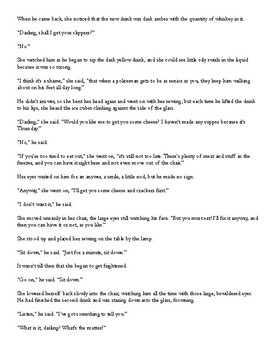

Along with this, Dahl presents Patrick as direct but sensitive. She didn’t feel like she could move even a yard at the moment.” This portrays Mary’s true shock at the situation by showing that the night’s events are unraveling quickly and overwhelmingly, but it is also direct, avoiding lengthy dialogue or rigid suspense. For the most part, Dahl skips dialogue and narrates in paragraph form: “Jack Noonan asked if she wouldn’t rather go somewhere else… No, she said. Rather than drawing out the storyline with suspense, tension, and dialogue, Dahl follows the plot directly with cadence. In Roald Dahl’s original short story, the plot’s progression is more direct, Patrick is less insensitive, and Mary’s motives for covering up her crime are somewhat understandable. The film differs from the short story in progression, character depiction, and how self-absorbed Mary’s motives appear. It opens us up to the idea that she might have planned out every step towards covering up Patrick’s murder before the night it took place. After this it is hard to imagine that Mary’s motives could include anything other than self-interest. This diminishes any sympathy the viewers might’ve had for Mary. He also closes the film by telling the viewers that Mary attempted to kill her husband “the same way,” with uncooked meat. In contrast to Mary’s quiet giggle at the end of the short story, Hitchcock’s ending shows Mary smiling and giggling maniacally. Though Hitchcock portrays Patrick as a stereotypical antagonist, he does not try to make Mary into a relatable or heroic protagonist.

Unlike Dahl, Hitchcock reveals to the viewers that Patrick hasn’t been loyal to his wife or his marriage through a conversation between two detectives, one saying that Patrick “used to fool around a bit now and again.” Patrick is also very cold and condescending to Mary in the way he speaks to her. Hitchcock also presents Patrick in a way that makes him seem like the antagonist everyone wishes for- an insensitive and harsh villain. In order to do this, he has Mary talk through her denial after Patrick speaks of leaving her, saying “You can’t go… Patrick, I won’t let you!” This integration of dialogue with a few well-placed silences leads the viewer to suspect Mary’s intentions long before she kills Patrick. Hitchcock’s version contrasts the directness of the short story by slowing down the progression with the addition of suspense and dialogue. The film is suspenseful compared to the short story’s direct progression, Patrick is depicted as more of an antagonist in the film, and Mary’s motives for covering up the murder are more understandable in the text.Īlfred Hitchcock’s film adaptation of “Lamb to the Slaughter” differs from the text through an adjustment of the progression, an intriguing depiction of Patrick’s character, and a lack of sympathy for Mary and her motives. However, Roald Dahl’s short story “Lamb to the Slaughter” and Alfred Hitchcock’s film version have subtle differences that compliment the similarities.

Short stories and film adaptations are typically known for their wild differences and adjusted story lines.


 0 kommentar(er)
0 kommentar(er)
